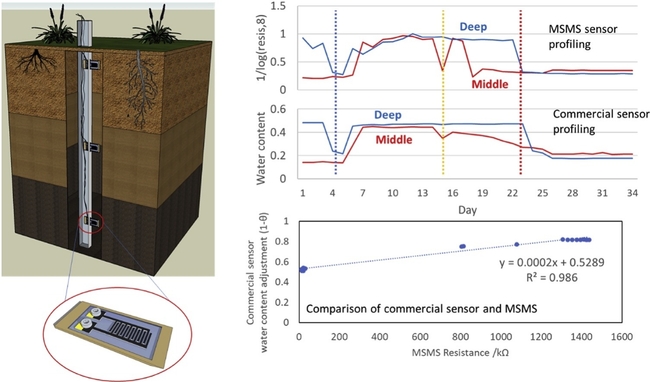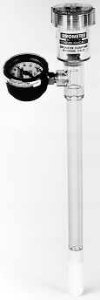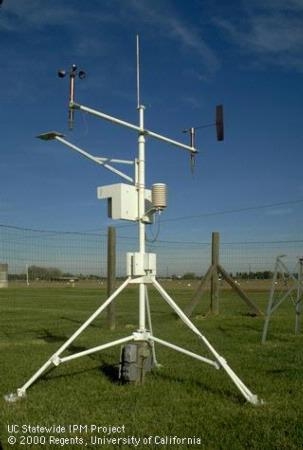
Posts Tagged: sensors
Soil Health Webinar
The University of California Cooperative Extension San Diego County presents:
The Climate Action & Agriculture Symposium Webinar:
Soil Health
The health and safety of our communities is a priority. Due to Coronavirus disease 2019(COVID-19), the UC Cooperative Extension is hosting a FREE webinar in lieu of the day-long event as previously announced.
Thursday, May 21,2020
1:00pm–3:30pm|FREE: Registration Required
Description:
The Climate Action and Agriculture Symposium focuses on the policies, research, programs, strategies and resources needed to support sustainable agriculture and the reduction of greenhouse gas emissions via the unique agricultural environments and industry in San Diego County.This symposium is intended to bring together agricultural producers, policy makers, government agencies, researchers, educators, consultants and other public and private agricultural service providers.
Presentations:
Climate Trends & Impacts to Agriculture
Tapan Pathak, Ph.D., UCANR Specialist,Climate Adaptation in Agriculture
Integrated Soil Management
Joji Muramoto, Ph.D., UC ANR Specialist, Organic Production
Mulching and Cover Crop Strategies: Avocados and Other Orchard Crops
Ben Faber, Ph.D., UCCE Farm Advisor
Cover Crop Strategies: Vegetables
Oli Bachie, Ph.D., UCCE County Director-Imperial & Farm Advisor
Spadra Farm Healthy Soils Program Research and Demonstration Project
TBA- Agriculture & Plant Science Departments, California State Polytechnic University, Pomona
Opening Remarks by Hannah Gbeh,
Executive Director, San Diego County Farm Bureau
Lightening Talk Session:
Brief updates on recent and current climate and agriculture projects.
TALKS INCLUDE:
CDFA/UC ANR Healthy Soils Program, County of San Diego Compost & Mulch Market Study, Climate Science Alliance 2020 Climate Change Consortium for Specialty Crops, San Diego Food System Alliance Food Vision 2030,and more.
Jan Gonzales(jggonzales@ucanr.edu)
New Cheap Soil Moisture Sensor?
A team of University of Connecticut researchers engineered a soil moisture sensor that is more cost effective than anything currently available and responds to the global need to regulate water consumption in agriculture. https://today.uconn.edu/2019/09/engineers-produce-water-saving-crop-irrigation-sensor/
Designed and tested on the university's farm, the sensors are small enough to insert into the soil with ease and less expensive to manufacture than current technology, the researchers write in the Journal of Sensors and Actuators.
“Advances in hydrological science are hampered by the lack of on site soil moisture data,” said Guiling Wang, study author and professor of civil and environmental engineering at UConn. “It's really hard to monitor and measure things underground. The challenge is that the existing sensors are very expensive and the installation process is very labor intensive.”
The sensors developed by the team of UConn engineers — environmental, mechanical, and chemical — are expected to save nearly 35% of water consumption and cost far less than what exists. Current sensors that are used in a similar way range from $100 to $1,000 each, while the one developed at UConn cost $2, according to the researchers.
An alternate monitoring option, soil moisture data collected from remote sensing technology such as radars and radiometers on board satellites, have suffered from low resolution. But the new technology developed by UConn Professor Baikun Li's group can provide high spatio-temporal resolution data needed for hydrology model development in Wang's group.
In the UConn prototype, wires are connected from the sensors to an instrument that logs data. Researchers conducted field tests of the sensors — performing side-by-side tests with commercial sensors under various environmental conditions throughout a 10-month period. The effects of the environmental variations on soil moisture throughout the period were clearly reflected.
Critically, the small sensors can also be easily sent around he world given the fact that soil moisture plays a fundamental role in agricultural decision-making globally.
Accurate soil moisture sensing is essential to ensure a water level that produces the most robust crops while not wasting the natural resource. In some states in the U.S. — Florida and California, for example — irrigation water usage has become tightly restricted.
The UConn researchers are also working on a nitrogen sensor that is the same model of the water sensors. These would help provide farmers with information on when fields need fertilizing. Currently, nitrogen sensors are not available using this type of technology.
“This is really an exciting start to a much larger scope of things we have in mind,” says Li, a study author and professor of civil and environmental engineering.
Towards water-saving irrigation methodology: Field test of soil moisture profiling using flat thin mm-sized soil moisture sensors (MSMSs)
WangchiZhouaZhihengXuaDannyRossaJamesDignanbYingzhengFanaYuankaiHuangaGuilingWangaAmvrossios C.BagtzoglouaYuLeicBaikunLia
https://doi.org/10.1016/j.snb.2019.126857Get rights and content
Abstract:
This study examined flat thin mm-sized soil moisture sensors (MSMS) fabricated using thermal press technology on thin compact disc (CD) to solve the long-standing problems of soil moisture profiling. The 10-month field tests conducted at a farm site compared three groups of MSMS with commercial capacitance-type soil moisture sensors (SMS) in terms of accuracy, sensitivity to environmental variations (e.g. water shock, temperatures, dry/wet seasons) and long-term stability. MSMS sensors were mounted on the shallow, middle and deep locations of a hollow plastic rod (length: 1.1?m) and installed along the soil depth to profile the soil moisture variation. The resistance readings of MSMS sensors along soil depth were recorded in a real-time mode. Due to soil settlement over time after installation, the MSMS sensors in the shallow soil suffered from unstable readings, while the MSMS sensors in the middle and deep soil exhibited high stability and had the best correlation with water content values of commercial sensors (R2 value: 0.6264). The contact between MSMS surface and soil particles appeared to be a critical factor determining the stability of MSMS readings. In addition, MSMS sensors showed a prompt response to the sharp change of soil moisture in the water shock tests. The soil moisture profiles collected from MSMS sensors captured the spatiotemporal variation of soil moisture, which enabled the simultaneous profiling at multiple locations. This field study demonstrated the great potential of mass deployment of low-cost but accurate MSMS sensors to achieve high resolution profiling for water-saving irrigation.

soil moisture sensor photo and charts
Whas Up in Subtropics?
There's a new Topics in Subtropics Newsletter available:
- Ah, Rats! ?
- So You Want To Install Soil Moisture Meters? ?
- Notes on Applying Gibberellic Acid (GA) to Navels in
the Southern San Joaquin Valley of California ? - Fall Leaf Tissue Sampling ?
- FREE! Citrus: UC IPM Pest Management Guidelines
http://ceventura.ucanr.edu/newsletters/Topics_in_Subtropics71533.pdf
Subscribe:
http://ceventura.ucanr.edu/news/Topics_in_Subtropics/

topics
Soil Moisture Sensor Selection is Confusing
So, every few weeks the question comes up of whether to install soil moisture meters which leads to the question of which to buy and install or have installed. And then come the questions of what do the readings mean and why aren't the readings consistent. Or maybe this question arrives after the grower has installed the sensors or system and the values don't conform to a known or knowable pattern.
The first question to the grower is why they want to install soil moisture sensors or a system. Everyone has a different answer which I've always found interesting. Usually it boils down to having more or better information, although it's hard to beat a good old soil auger. Which takes time and labor.
So once that is cleared up, it comes down to what area they want to monitor. Is it an acre, 10 acres, 50 acres, 100 acres, 200 acres, 1,000 etc.? What are the different irrigation blocks, soil types, aspects? How complex is the area that is to be monitored? Do they need one monitoring site or many? Can the information be gathered in the field, or does it need to be accessed from a distance? Linked by hardwire, infrared, cell phone, wifi, satellite, etc.?
Then the question is does the grower do the installation or is it done by a company? And then whatever the case is, who maintains the system and for that matter, who maintains the information? What software is used and who interprets it?
And what sensors are being used: tension, electrical resistance, conductance, capacitance, electromagnetic…….? The list seems to go on and there are no models and brands coming out on a regular basis. And how reliable are the sensors? What's their lifespan? And what are they measuring and in what units? How affected are the readings by salinity and what soil volume are they measuring? And how important is their placement?
This last point is so often overlooked. The sensor needs to be in the active root zone where water is being taken up. Not where it's convenient to read, not where the plants cant use the water. Placement is so often overlooked.
And then how much do you want to spend? $100 per installation, $1000? With a monthly or yearly maintenance fee or none? Who responds when there are problems?
Wow, so yeah, there are lots of questions. Here's a chart that might help categorize some of the questions:
|
Method |
Cost |
Ease of use |
Accuracy |
Reliability |
Salt-affected |
Stationary |
|
Gypsum block |
L |
H |
H |
H |
L |
YES |
|
Tensiometer |
L |
M |
H |
M |
L |
YES |
|
Portable tensiometer |
M |
M |
H |
M |
L |
NO |
|
Solid-state tensiometer |
M |
H |
H |
H |
L |
YES |
|
Time domain reflectometer |
H |
M |
H |
H |
M |
BOTH |
|
Neutron probe |
H |
L |
H |
H |
L |
YES |
|
Feel (soil probe) |
L |
H |
H |
H |
L |
NO |
|
Gravimetric (oven) |
L |
M |
H |
H |
L |
NO |
|
Conductance |
L |
H |
M |
M |
H |
BOTH |
|
Capacitance |
M |
H |
M |
H |
M |
BOTH |
H, high; M, medium; L, low
And the good Almond Doctor might help some more:
http://thealmonddoctor.com/2015/07/10/soil-moisture-sensing-systems/
And maybe some of these publications can help sort out what questions to ask
http://calag.ucanr.edu/Archive/?article=ca.v054n03p38
http://calag.ucanr.edu/Archive/?article=ca.v054n03p47
http://anrcatalog.ucanr.edu/Details.aspx?itemNo=21635
Khaled Bali, our Irrigation Specialist at Kearney Research and Education Center near Fresno, is part of a group in the process of evaluating different types and models of soil moisture sensors. He should have a publication that can more accurately sort through the many sensor choices that are available at this time. But in time, there should be more models on the market and new update will be necessary.
The question, though, is to ask yourself how irrigation is being done and how it can be improved. The basics of design, maintenance, distribution uniformity and how scheduling is being currently done – when and how much to apply. Definitely, soil moisture sensors can help, but you gotta know how to use them and maintain them, just like the whole irrigation system.
A grower who uses tensiometers told me that people think of soil sensors as though they were reading a book. Something cut and dried. A simple plot line that you follow. Irrigation is not a book. There are many other subplots to irrigation than just reading the digital face. Looking at the weather, evapotranspiration, the tree, how fast the moisture is depleted, how deep the moisture is being pulled from all contribute to the "sensors" used to irrigate. Use them all. Even though this grower has irrigators on 250 acres of trees, he also checks the orchard tensiometers at least once a week on his own to confirm all of his senses.

tensiometer2

cimis
Soil Moisture Sensors
Soil moisture sensors fall into two broad categories, volumetric and tensiometric methods. One tells you how much water is in the soil and the other tells you how tightly the soil holds on to the water. Volumetric methods require a calibration of the sensor to the soil, whereas tensiometric is good to go when installed. For both methods, the grower learns to keep soil moisture within a given range of values and, in theory, the plant is kept in a better condition with improved health and yields and potential improved irrigation efficiency.
The most common volumetric methods rely on utilizing the dielectric constants of the soil and water, with water’s dielectric constant being much greater than soils’. The velocity of an electromagnetic wave or pulse depends on soil moisture content. These sensors have become widely used because they have a good response time, do not require maintenance and can provide continuous readings, allowing for automation. There are several different methodologies used: Time Domain Reflectometry, Frequency Domain Reflectometry (Capacitance), Amplitude Domain Reflectometry (Impedance), Phase Transmission, and Time Domain Transmission. There is quite a range in: (1) prices for these different devices, (2) requirements for calibration with soil moisture content, and (3) requirements for close soil contact. Some devices are affected by the chemical nature of the soil. Even if they are not calibrated they can be used as relative change in moisture content over time.
The tensiometric methods include: Tensiometers, Gypsum Blocks, Granular Matrix Sensors, Heat Dissipation and Soil Psychrometer. These techniques require the sensor to come into equilibration with the soil moisture and generally are unaffected by soil salinity. Gypsum blocks and Granular Matrix are not very responsive in sandy soils and require good soil contact. These methods are less affected by salinity and do not require soil calibration, because they are reflecting the soil moisture tension the roots are seeing.
All soil moisture sensors need to be placed in a position that represents the irrigated area. They need to be placed in the active root zone where water is applied and taken up and must be near trees representative of the whole irrigated area. They should not be next to a sick tree, a smaller tree compared to the other trees or be in an area that obstructs applied water (such as under a canopy that intercepts applied water). It is always best to reinforce sensor values with manual field measurements with a soil probe to ensure that sensor placement and response is truly reflective of what is going on in the field, before completely relying on the sensor values. As with all field equipment, occasional visual inspection of the field and sensor readings should be made to make sure the situation has not changed, such as an emitter has clogged or broken near the sensor.
Volumetric Sensors
|
|
TDR |
FDR |
ADR |
PT |
TDT |
|
Appx. Cost (including logger/reader)+ |
$400- 20,000 |
$100-3,500 |
$500-700 |
$200-400 |
$400-1,300 |
|
Field Maintenance |
No |
No |
No |
No |
No |
|
Affected by salts |
High levels |
Minimal |
No |
>3dS/m |
High levels |
|
Soil type not recommended |
Organic, salt, high cay |
None |
None |
None |
Organic, salt high clay |
+ Prices as of 2009
Tensiometric Sensors
|
|
Tensiometer |
GB |
GMS |
HD |
SP |
|
Appx. Cost (including logger/reader)+ |
$50-300 |
$400-700 |
$200-500 |
$300--500 |
$500-1000 |
|
Field Maintenance |
Yes |
No |
No |
No |
No |
|
Affected by Salts |
No |
>6 dS/m |
>6dS/m |
No |
maybe |
|
Soil Type not recommended |
Sandy |
Sandy, high clay |
Sandy, high clay |
Sandy |
Sandy, high clay |
These sensors can be purchased individually and installed by the grower, or increasingly there are companies that provide a monitoring station that includes soil moisture, sensors for estimating plant evapotranspiration , data logger and software that determines an irrigation schedule for the crop. Some of these systems are outright purchase and some are for lease. In the future, there will be affordable satellite imagery that can help in irrigation scheduling, showing how rapidly this technology is changing.

tensiometer2

